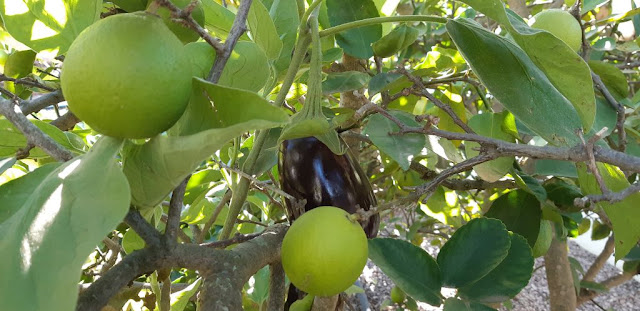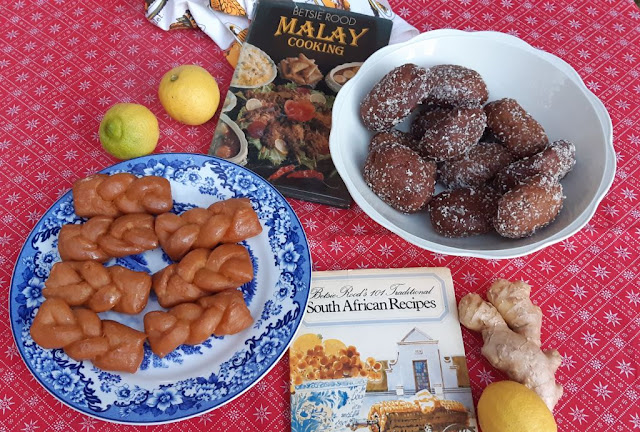After efforts towards finding information about the origins of
Koeksisters in my traditional South African cookbooks, I recalled Hester Wilhelmina Claassens’ thesis for her doctorate written in 2003, “Die Geskiedenis van Boerekos 1652-1806”. A shortened version of this
thesis was published in a book of the same title in 2006.
In her thesis, “Die Geskiedenis van Boerekos 1652-1806” (2003), Hester
Wilhelmina Claassens explains the origins of the Koeksister, Koesister and
Bollas.
She writes that the most popular cake in 17th century Holland
was “stroopkoek” (syrup cake). From literary descriptions, it seems that the
“stroopkoek”and “oliekoek” (oilcake) was the same thing. The recipe for
oliekoek in the “De verstandige kock (1668)” contained raisins, apples and
almonds, apart from the cinnamon, cloves and ginger. The dough was fried in
deep fat and then rolled in a “syrup”. The syrup that was used to dip the
dumplings was not a liquid but only melted sugar. Oliekoek was called (Olie)Bolle
at the Cape. In the old Cape recipe manuscripts, the Malay people used to refer
to Bolle or Bollas. These recipes are the same as an original Arabian recipe.

My further research on the subject suggests that the Arabian recipe
appears to have come to Andalusia (Southern Spain) during its dominant Muslim
period (roughly 700 -1200). When Spanish rule came to the Southern Netherlands
and neighbouring territories in the period 1556 -1714, the recipe most likely
came with and became part of the Dutch culinary tradition. This tradition then
followed the Dutch to their colonies in the east, Batavia and other territories
like the Cape.
(See an Arabian recipe from the 13th Century in my post
Koeksisters, Koesisters and Bollas.)
In Hilda Gerber’s “Traditional
cookery of the Cape Malays”, she shares a recipe of Mrs Galiema S., off Hanover
Street, Cape Town. It is a recipe for cinnamon flavoured, sugarless “Bollas”
that was not dipped in syrup. The dough for Bollas is rolled out and pressed in round forms. According to Mrs Galiema, these Bollas were enjoyed for
breakfast on Sundays instead of Koeksisters. A custom that continues today in
some homes.
 |
| Traditional Cookery of the Cape Malays [Hilda Gerber] |
The earliest recipe for Bolle Claassens could find was in the Versfeld
manuscripts, circa1800. In the Cape, the Bolle that was not dipped in sugar or
syrup was known as “Vetkoek” because it was mostly fried in fat.
According to Claasens, the recipe for Crullers that became koeksisters
at the Cape, dates to the 15th century cook Martino, the head cook
of the Holy Patriarch of Aquileia. He used sliced dough to make Crespelli (now
called Cenci). He explained that the dough could be plaited or turned in any
form before it is baked in fat. After it was baked it was sprinkled with
cinnamon sugar. Crullers that are plaited like koeksisters and dipped in sugar
and not syrup can be found in Europe and Scotland.
 |
| Aberdeen Crulla, German Crullers, Danish Klejne, Bugnes de Lyon and Fattigman |
One can find the resemblances in the Aberdeen Crulla, Danisk Klenje,
German Crullers, Swedish Fattigman and many more.
In the Cape, some confusion originated when the same dough started to be
used for the ”Oliebol” (without the fruit) and the Cruller. According to
Claassens’ thesis, it is not clear when the same dough first began to be used
for the different confectionaries.
Claassens notes the fact that the same dough was used for “Oliebolle” and
Crullers/koeksisters. This is also clear from Mrs Galiema’s words in Hilda
Gerber’s book “Traditional Cooking of the Cape Malays”: "Make Bollas
exactly like Koesisters, but add cinnamon." To add to the confusion,
plaited Crullers started to be called Koeksisters.
Claassens has a very interesting explanation for the origin of the name Koeksister,
“Die oorspronklike Kaapse benaming koeksusters - vir gevlegte krullers -
se oorsprong lê waarskynlik by die koeke genaamd Groote zuster, Kleine zuster
en Kuische Zuster. Dié resepte het in De volmaakte Hollandsche keuken-meid
(1761) en waarskynlik ook in die eerste uitgawe in 1746 verskyn. Dit is
moontlik dat die naam koeksuster wat vir die gevlegte vorm meer beskrywend as
kruller was, na aanleiding van die name van bogenoemde koeke ontstaan het. Die
meeste kokke het die deeg vir koeksusters in drie repe verdeel om te vleg. Die drie repe is moontlik
met die name van bogenoemde drie koeke verbind en daarom is daarna as
koeksusters verwys. Sinkopee van die [k] aan die einde van die eerste
lettergreep en die ontronding van die [u] in die tweede sillabe van die woord,
was te wyte aan sowel slordige uitspraak as Engelse invloed. Van Dale se
Handwoordenboek der Nederlandse taal het nie 'n woord soos "sister"
nie, en volgens Verdam se Middelnederlandsch handwoordenboek, is die vorms
"sister, zester, sester" gebruik om 'n inhoudsmaat aan te dui en kan
dit dus buite rekening gelaat word as betekenisdraer in 'n vorm soos koeksister
wat vandag deur baie mense as die oorspronklike naam beskou word.
Volgens die Etimologiewoordeboek van Afrikaans is sister in die
samestelling koeksister, moontlik 'n vervorming van sisser wat verwys na die
geluid wat die deeg in die kokende olie maak. Dit is egter onwaarskynlik dat
sprekers in die omgangstaal 'n maklike uitspraak met 'n dubbele [s] sal verruil
vir 'n ingewikkelder uitspraak waar die stand van die tong van [s] na 'n
sluitklank [t] moet verander. Aangesien Groote zuster, Kleine zuster en Kuische
zuster se resepte op die vroegste net voor die middel van die agtiende eeu kon verskyn
het, moes die benaming koeksuster eers daarna in gebruik begin kom het. Voor daardie
tyd is die Hollandse naam cruller waarskynlik gebruik. Die feit dat die
verwarring met die benaming tot byna die helfte van die twintigste eeu
voortgeduur het, dui moontlik daarop dat die naamsverandering eers laat in die
agtiende eeu begin het.”
Loosely summarized, Dr Claasens’ research findings on the subject are that
the name Koeksister, for what was essentially a braided Dutch Kruller, apparently
originates from three variants of the Kruller published in a Dutch recipe book
in 1746 and again in 1761. These variants were known as Groote Zuster (Big
Sister), Kleine Zuster (Small Sister) and Kuische Zuster (Chaste Sister). The
common fundamentally dominant elements of these recipes make up the recipe for
the Koeksister. The three braids reference the three sister cakes. Dr Claasens
also unpacks the etymology of the sister portion of the name Koeksister.
Dr Claassens' thesis is interesting and professionally
researched. It is a must-read for anybody interested in the culinary history of
South Africa. It is a pity that it is only available in Afrikaans. If more
people knew about her research and explanation of the origin and name of the
koeksister, there might be less need for speculation on the subject.
Sometimes people prefer not to know the researched academic explanation
of things and find comfort in the oral history and mystical legend of the familiar.Source: Die geskiedenis van Boerekos 1652-1806 - Claassens, Hester Wilhelmina, Thesis (DPhil)--University of Pretoria, 2005.
More posts about Koeksisters on this blog.
Koeksisters, Koesisters and Bollas
Koeksisters en Koffie (Afrikaans)
Dried naartjie peel





































